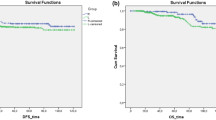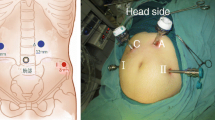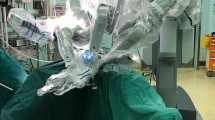Abstract
Background
Robotic total mesorectal excision (RTME), a novel approach for the treatment of rectal cancer, has been shown in previous studies to be safe and effective. However, the results of this approach compared with laparoscopic total mesorectal excision (LTME) have not been reported in terms of clinical outcome and oncologic data. This study compared early outcomes for rectal cancer between two groups.
Methods
Between April 2003 and March 2009, 82 patients from a prospectively maintained database were enrolled in a case-matched study. The patients were matched for gender, age, body mass index (BMI), and type of operative procedure.
Results
Neoadjuvant chemoradiotherapy was performed for 33 RTME patients (80.5%) and 18 LTME patients (43.9%) (p = 0.001). The mean operative time was 296 min for RTME and 315 min for LTME (p = 0.357). The number of conversions were 3 (7.3%) for RTME and 9 (22%) for LTME (p = 0.12). The anastomotic leak rate after surgery did not differ between RTME (n = 3, 8.6%) and LTME (n = 1, 2.9%) (p = 0.62). The mean number of harvested lymph nodes was 13.1 with RTME and 16.2 with LTME (p = 0.07), and negative distal resection margins (DRMs) were noted in all surgical specimens. Positive circumferential resections (CRMs) were identified in 2.4% of the RTME cases and 4.9% of the LTME cases. No difference was noted in lengths of the DRMs, times until a liquid diet, or postoperative hospital stays. The total hospitalization costs were higher in the RTME group, although the difference did not reach statistical significance. There was no operative mortality or port-site recurrence in either group.
Conclusion
For rectal cancer, RTME may be as feasible and safe as LTME in terms of technical and oncologic issues. Further prospective randomized trials are necessary for conclusions to be drawn concerning definite oncologic outcomes of robotic procedures for rectal cancer.
Similar content being viewed by others
Avoid common mistakes on your manuscript.
Laparoscopic colorectal cancer surgery has advantages over open resection in terms of postoperative recovery, pain, cosmesis, and length of hospital stay [1, 2]. However, limitations of laparoscopic surgery include tremor, unstable two-dimensional view, and limited degree of freedom of the instruments. These downsides are particularly relevant for rectal cancer patients with a narrow pelvis undergoing total mesorectal excision (TME) [3]. Robotic surgery has the potential to overcome some of these limitations, provide comfort, and offer technical abilities independent of the laparoscopic or open technique [3–5].
To date, a few series of robotic rectal cancer surgeries have been reported, including two by our group [4–9]. Only two studies, with a small number of cases, have compared results between robotic and laparoscopic TME [4, 5]. In this study, we compare our experience with both techniques used to treat patients with rectal cancer.
Methods
Between April 2003 and March 2009, 108 patients underwent robot-assisted and 48 had conventional laparoscopic rectal surgery for primary rectal cancer at the City of Hope National Medical Center. All relevant data were entered in a prospectively maintained database.
In this study, RTME cases were matched to LTME cases by gender, age (<60 and ≥60 years), body mass index (BMI) (<30 and ≥30 kg/m2), and type of operative procedure. Patients with anal cancer, benign tumor, recurrent tumor, or concomitant surgery for a major organ were excluded from the analysis. Groups were compared for conversion rate, operative time, estimated blood loss, rate of diverting stoma formation, distal resection margin (DRM), circumferential resection (CRM), number of harvested lymph nodes, time to liquid diet, length of hospital stay, morbidity, and mortality. Tumor location was classified according to the tumor’s distance from the anal verge as measured by endoscopy or endorectal ultrasound. The location of the tumor in the rectum was demarcated according to its distance from the anal verge, namely, lower (<7 cm), mid (7–11 cm), and upper (11–15 cm) rectum. Involvement of CRM was defined as a CRM of 1 mm or less. Postoperative mortality was defined as 30-day or in-hospital mortality. The RTME and LTME surgical techniques have been described previously [4].
Categorical and ordinal variables were cross-tabulated and analyzed using the Pearson chi-square test and Fisher’s exact test. Continuous variables were presented as mean values and compared using Student’s t-test. Statistical analysis was performed using the SPSS statistical software program (SPSS v.16.0; SPSS, Chicago, IL, USA), with p values less than 0.05 considered statistically significant. This study was approved by the institutional review board (IRB) of our institution.
Results
A total of 41 patients were included in each group. Whereas the patient baseline characteristics (Table 1) were similar in the two groups with regard to American Society of Anesthesiology (ASA) score, history of abdominal surgery, tumor location, and tumor stage, more patients in the RTME group than in the LTME group underwent neoadjuvant chemoradiotherapy (p = 0.001).
The operative outcomes are listed in Table 2. The number of conversions was higher with LTME (n = 9) than with RTME (n = 3), although the difference did not reach statistical significance. The mean BMI of the converted patients was 30.5 kg/cm2 in the RTME group and 31 kg/cm2 in the LTME group.
The justifications for conversion to open surgery are listed in Table 3. A temporary diverting ileostomy was performed for 33 RTME patients (94.3%) and 14 LTME patients (40%) (p < 0.001), with similar operation times noted for the two groups.
All DRMs were negative, and the mean number of harvested lymph nodes was 13.1 in the RTME group and 16.2 in the LTME group. Positive CRMs were identified in one RTME patient (2.4%) and two LTME patients (4.9%) (p = 1.00).
Pelvic septic complications occurred for five RTME patients (3 anastomotic leaks and 2 abscesses) and two LMTE patients (1 anastomotic leak and 1 abscess). Although the average total hospitalization costs were higher in the RTME group ($83,915) than in the LTME group ($62,601), these differences were not statistically significant (p = 0.092). No 30-day mortality occurred in either group.
Discussion
From this case-matched study, we report the perioperative outcomes for 82 patients who underwent robotic or laparoscopic TME surgery for rectal cancer. We considered the most suitable variables for matching the two groups based on clinical characteristics and surgical procedure. Matching by gender, age, BMI, and exact type of surgery allowed us to obtain consistent data for operative time, estimated blood loss, and rate of leakage for comparison of the two groups. That also was the reason for excluding from the analysis patients who had surgery for recurrent tumors and those for whom we performed more than one surgery.
Our data suggest that the patients who underwent RTME had a lower conversion rate (7.3%) than those subjected to LTME (22%), although the difference did not reach statistical significance (p = 0.116). One possible explanation of this finding is that most LTME cases were performed early in our experience with minimally invasive rectal surgery, whereas the RTME cases tended to be more recent procedures, a fact that may have shortened our learning curve for RTME. However, it also is possible that the limitations of conventional laparoscopic instruments and cameras compared with robotic ones also may have resulted in an increased conversion rate for the LTME group.
In our experience, the robotic approach facilitates pelvic dissection [4]. It is possible that a larger study may have highlighted more significant differences between RTME and LTME in terms of conversion, especially if the use of neoadjuvant therapy, which may increase the technical difficulty of the dissection, had been similar in the two arms of the study.
The conversion rate in the LTME group was consistent with those of previous published studies showing conversion rates of 1 to 34% [2, 10–14]. According to the conventional versus laparoscopic-assisted surgery in colorectal cancer (CLASICC) trial [2], the conversion rate for the patients who underwent laparoscopic rectal surgery was 34%. In the CLASICC trial, the main reasons for conversion were tumor fixity or uncertainty of tumor clearance, obesity, anatomic problems, and tumor inaccessibility. These problems also were encountered in most of our converted cases.
The limitations of the current study included the fact that although both groups were well matched in terms of patient and clinical characteristics, considerable differences existed such as the higher rate of stoma creation and the use of neoadjuvant chemoradiation in the RTME group, which may have had an impact on postoperative outcomes. These differences may reflect a certain surgeon bias favoring the use of robotic surgery for more locally advanced rectal cancer cases. Despite these limitations, the analysis did not highlight major differences between the two techniques in terms of perioperative and pathologic outcomes.
Laparoscopic rectal surgery is especially difficult in a narrow and deep pelvic cavity, demanding high levels of experience and a significant learning curve [15]. Robotic surgery may be useful for overcoming some of the limitations associated with conventional laparoscopic rectal surgery because it provides a stable, high-definition three-dimensional image, fine dissection by use of articulated tools, and comfortable ergonomics for the surgeon. Nevertheless, current robotic technology has some limitations such as lack of tactile feedback and limited instrumentation, which need to be improved. In addition, studies on the learning curve for robotic colorectal surgery have not been reported in the literature to date.
In 2006, we first reported RTME with autonomic nerve preservation for rectal cancer using a hybrid laparoscopic abdominal and pelvic robotic technique for six consecutive patients, with acceptable short-term outcomes [4]. Baik et al. [5] randomly assigned 18 patients with rectal cancer to robotic tumor-specific mesorectal excision (R-TSME) or laparoscopic tumor-specific mesorectal excision (L-TSME) and reported similar postoperative and oncologic outcomes for the two methods, although the patients in the robotic arm of the study had a decreased hospital stay.
Although robotic surgery often is perceived as time consuming, our series had a mean operative time of 296 min in the RTME group and 315 min in the LTME group. The operative time was comparable with those reported in large laparoscopic TME series, which range from 180 to 360 min [2, 10–12]. Interestingly, the mean operative time for RTME was shorter than for LTME because of high conversion rates in the laparoscopic group. In our experience, the mean docking time for the robotic system in rectal surgeries is approximately 5 to 10 min.
The mean time until a liquid diet was 2.3 days with RTME and 2.4 days with LTME, and the median hospital stays were respectively 6.5 and 6.6 days (p = 0.873). These recovery outcomes were consistent with the improved recovery times noted in other laparoscopic rectal surgery studies [11, 16]. For these patients to avoid unnecessary delays in adjuvant therapy, rapid recovery may be important.
Anastomotic leakage occurred more frequently in the RTME group (3 patients, 7.3%) than in the LTME group (1 patient, 2.4%), but the difference did not reach statistical significance (p = 0.616). The number of patients who underwent preoperative chemoradiotherapy in the RTME group was greater than in the LTME group (80.5% vs 43.9%; p = 0.001), which may have influenced the anastomotic leak rate. Overall, our anastomotic leak rates in the two groups also were comparable with other previously reported rates in large laparoscopic and open surgery series [2, 11–14, 16–19].
The TME procedure for rectal cancer has become standard. Violations of the mesorectum or the margins increase the risk of local and distant recurrence. In previous reports, the positive rate for CRM after laparoscopic rectal cancer surgery ranged from 4.2 to 16% [2, 20, 21]. In our study, overall CRM positivity rates were comparable with other reported rates and did not differ significantly between the RTME (2.4%) and LTME (4.9%) groups (p = 1.00). In contrast, pathologic examinations of the resected specimens showed that DRMs were negative in all patients after RTME or LTME.
The number of lymph nodes harvested in both groups also followed oncologic principles. Metaanalysis data showed no difference in the number of harvested lymph nodes between laparoscopic and open rectal surgery for rectal cancer [22]. Although the laparoscope provides a theoretically magnified view of the pelvis and good recognition of the pelvic autonomic nerves, the outcomes of male sexual function are not reported to be favorable [23, 24]. The CLASICC trial reported that 41% of men in the laparoscopic rectal surgery group had sexual dysfunction after LTME compared with 23% in the open surgery group [23]. In our series, we did not have enough functional data to compare the two techniques, and future prospective studies will be needed to examine the potential benefits of robotic surgery regarding preservation of genitourinary function.
Comparison of total hospitalization costs for both groups showed higher costs for the RTME patients than for the LTME patients, but the difference was not statistically significant. Although this is, to our knowledge, the first study comparing total hospital costs between RTME and LTME for rectal cancer surgeries, the cost data should be carefully interpreted because expenses may differ significantly from hospital to hospital.
Conclusions
In conclusion, our results suggest that both LTME and RTME are technically feasible and oncologically safe in experienced hands. For patients with mid and low rectal cancer, RTME may result in lower conversion rates than LTME. However, due to the higher cost of the technology, rigorous comparative prospective studies are needed to determine the potential benefits of robotic rectal surgery.
References
COST Study Group (2004) A comparison of laparoscopically assisted and open colectomy for colon cancer. N Engl J Med 350:2050–2059
Guillou PJ, Quirke P, Thorpe H, Walker J, Jayne DG, Smith AM, Heath RM, Brown JM (2005) Short-term end points of conventional versus laparoscopic-assisted surgery in patients with colorectal cancer (MRC CLASICC trial): multicentre, randomised controlled trial. Lancet 365:1718–1726
Ballantyne GH (2002) Robotic surgery, telerobotic surgery, telepresence, and telementoring: review of early clinical results. Surg Endosc 16:1389–1402
Pigazzi A, Ellenhorn JD, Ballantyne GH, Paz IB (2006) Robotic-assisted laparoscopic low anterior resection with total mesorectal excision for rectal cancer. Surg Endosc 20:1521–1525
Baik SH, Ko YT, Kang CM, Lee WJ, Kim NK, Sohn SK, Chi HS, Cho CH (2008) Robotic tumor-specific mesorectal excision of rectal cancer: short-term outcome of a pilot randomized trial. Surg Endosc 22:1601–1608
Hellan M, Anderson C, Ellenhorn JD, Paz B, Pigazzi A (2007) Short-term outcomes after robotic-assisted total mesorectal excision for rectal cancer. Ann Surg Oncol 14:3168–3173
Baik SH, Lee WJ, Rha KH, Kim NK, Sohn SK, Chi HS, Cho CH, Lee SK, Cheon JH, Ahn JB, Kim WH (2008) Robotic total mesorectal excision for rectal cancer using four robotic arms. Surg Endosc 22:792–797
D’Annibale A, Morpurgo E, Fiscon V, Trevisan P, Sovernigo G, Orsini C, Guidolin D (2004) Robotic and laparoscopic surgery for treatment of colorectal diseases. Dis Colon Rectum 47:2162–2168
Spinoglio G, Summa M, Priora F, Quarati R, Testa S (2008) Robotic colorectal surgery: first 50 cases experience. Dis Colon Rectum 51:1627–1632
Barlehner E, Benhidjeb T, Anders S, Schicke B (2005) Laparoscopic resection for rectal cancer: outcomes in 194 patients and review of the literature. Surg Endosc 19:757–766
Leung KL, Kwok SP, Lam SC, Lee JF, Yiu RY, Ng SS, Lai PB, Lau WY (2004) Laparoscopic resection of rectosigmoid carcinoma: prospective randomised trial. Lancet 363:1187–1192
Morino M, Toppino M, Bonnet G, del Genio G (2003) Laparoscopic adjustable silicone gastric banding versus vertical banded gastroplasty in morbidly obese patients: a prospective randomized controlled clinical trial. Ann Surg 238:835–841 discussion 841–832
Ng KH, Ng DC, Cheung HY, Wong JC, Yau KK, Chung CC, Li MK (2009) Laparoscopic resection for rectal cancers: lessons learned from 579 cases. Ann Surg 249:82–86
Staudacher C, Vignali A, Saverio DP, Elena O, Andrea T (2007) Laparoscopic vs open total mesorectal excision in unselected patients with rectal cancer: impact on early outcome. Dis Colon Rectum 50:1324–1331
Ito M, Sugito M, Kobayashi A, Nishizawa Y, Tsunoda Y, Saito N (2009) Influence of learning curve on short-term results after laparoscopic resection for rectal cancer. Surg Endosc 23:403–408
Braga M, Frasson M, Vignali A, Zuliani W, Capretti G, Di Carlo V (2007) Laparoscopic resection in rectal cancer patients: outcome and cost-benefit analysis. Dis Colon Rectum 50:464–471
Lee GJ, Lee JN, Oh JH, Baek JH (2008) Midterm results of laparoscopic surgery and open surgery for radical treatment of colorectal cancer. J Korean Soc Coloproctol 24:373–379
Enker WE, Merchant N, Cohen AM, Lanouette NM, Swallow C, Guillem J, Paty P, Minsky B, Weyrauch K, Quan SH (1999) Safety and efficacy of low anterior resection for rectal cancer: 681 consecutive cases from a specialty service. Ann Surg 230:544–552 discussion 552–544
Heald RJ, Moran BJ, Ryall RD, Sexton R, MacFarlane JK (1998) Rectal cancer: the Basingstoke experience of total mesorectal excision, 1978–1997. Arch Surg 133:894–899
Bretagnol F, Lelong B, Laurent C, Moutardier V, Rullier A, Monges G, Delpero JR, Rullier E (2005) The oncological safety of laparoscopic total mesorectal excision with sphincter preservation for rectal carcinoma. Surg Endosc 19:892–896
Kim SH, Park IJ, Joh YG, Hahn KY (2006) Laparoscopic resection for rectal cancer: a prospective analysis of thirty-month follow-up outcomes in 312 patients. Surg Endosc 20:1197–1202
Aziz O, Constantinides V, Tekkis PP, Athanasiou T, Purkayastha S, Paraskeva P, Darzi AW, Heriot AG (2006) Laparoscopic versus open surgery for rectal cancer: a meta-analysis. Ann Surg Oncol 13:413–424
Jayne DG, Brown JM, Thorpe H, Walker J, Quirke P, Guillou PJ (2005) Bladder and sexual function following resection for rectal cancer in a randomized clinical trial of laparoscopic versus open technique. Br J Surg 92:1124–1132
Quah HM, Jayne DG, Eu KW, Seow-Choen F (2002) Bladder and sexual dysfunction following laparoscopically assisted and conventional open mesorectal resection for cancer. Br J Surg 89:1551–1556
Acknowledgments
The authors thank Silvia R. da Costa, Ph.D, for revising and editing the manuscript.
Disclosures
Jeong-Heum Baek, Carlos Pastor, Alessio Pigazzi have no conflicts of interest or financial ties to disclose.
Author information
Authors and Affiliations
Corresponding author
Rights and permissions
About this article
Cite this article
Baek, JH., Pastor, C. & Pigazzi, A. Robotic and laparoscopic total mesorectal excision for rectal cancer: a case-matched study. Surg Endosc 25, 521–525 (2011). https://doi.org/10.1007/s00464-010-1204-x
Received:
Accepted:
Published:
Issue Date:
DOI: https://doi.org/10.1007/s00464-010-1204-x




